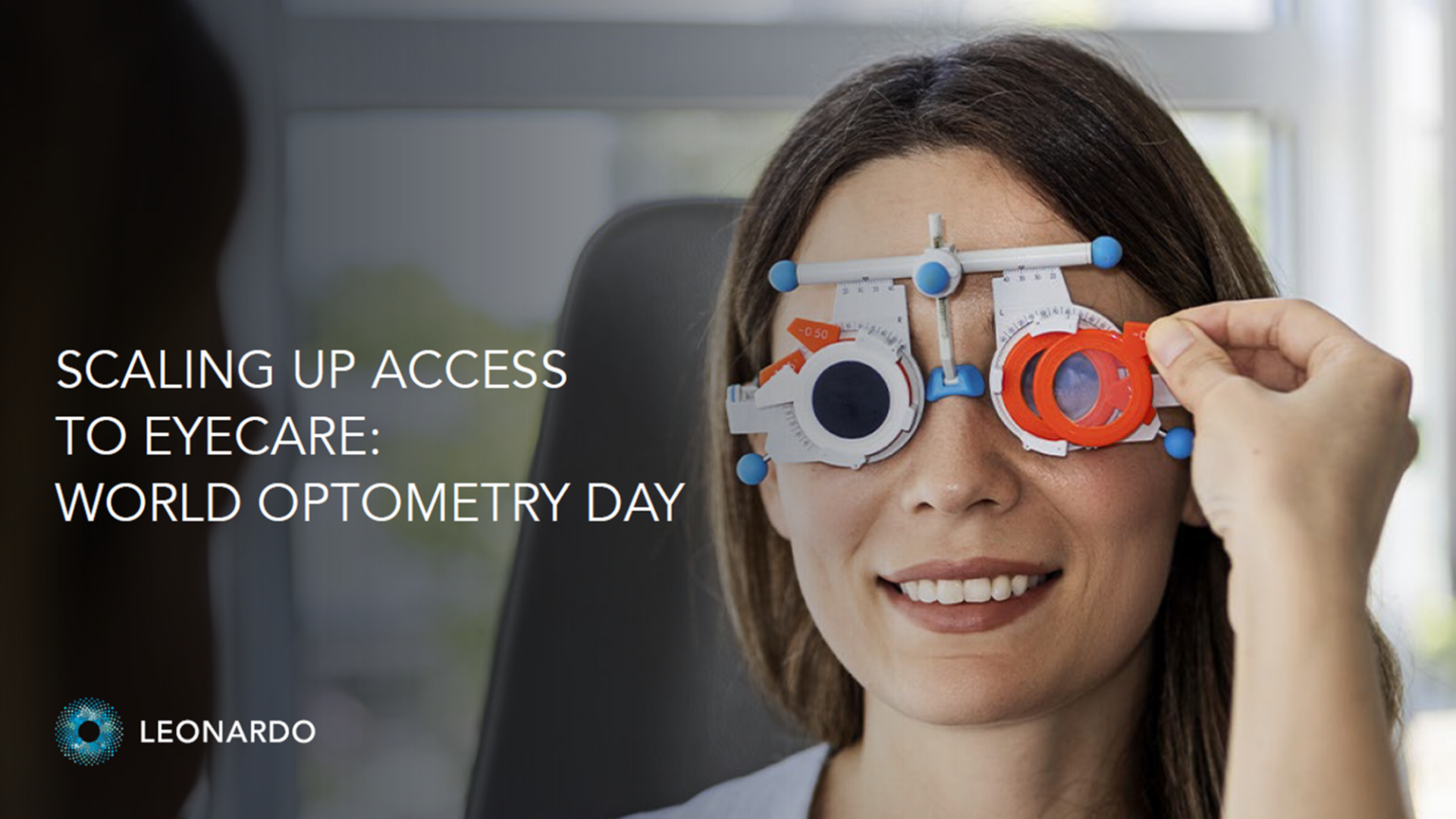On March 23, 2023, World Council of Optometry President, Prof. Peter Hendicott, participated in a panel discussion hosted by EssilorLuxottica, entitled ‘World Optometry Day: Scaling Up Access to Eyecare’. Learn more in the article below.
To celebrate World Optometry Day on March 23, 2023, EssilorLuxottica hosted a live event with international experts from various sectors in optometry on EssilorLuxottica’s learning platform, Leonardo. It was an exclusive panel discussion entitled ‘World Optometry Day: Scaling Up Access to Eyecare’.
The session was moderated by Olga Prenat, Head of Medical and Professional Affairs, & Head of Vision Care Education, EssilorLuxottica. Renowned experts Prof. Peter Hendicott, World Council of Optometry (WCO) President; Peter Holland, Chief Executive, International Agency for the Prevention of Blindness (IAPB); Stuart Keel, Technical officer, Sensory Functions, Disability and Rehabilitation Unit, World Health Organization (WHO); and Kovin Naidoo, Global Head, Advocacy and Partnerships, OneSight EssilorLuxottica Foundation, participated in the discussion.
World Optometry Day provides an opportunity to reflect on the role of optometry in society towards addressing vision care needs, public awareness of eye health and vision care, eye disease prevention and the role of eye care professionals in advancing vision care and eye health.
This occurs in the context of significant gains being made in enhancing the eye care and vision care agenda globally. The momentum gained by the eye care sector in the last few years can be linked to the 2019 WHO world report on vision that took stock of previous initiatives and challenges, and pushed forward a new strategy that provided a comprehensive approach to eye care. The 2020 resolution of the World Health Assembly and the United Nations, entitled Integrated people-centered eye care, including preventable vision impairment and blindness” , which is the first-ever resolution on vision at the United Nations aiming to ensure eye care for everyone by 2030, brought a sharp focus on eye care by posing targets that governments, NGOs, professional associations and the private sector will need to achieve. The 2021 World Health Assembly endorsed the global targets for effective coverage of refractive errors and cataract surgery to be achieved by 2030 – a 40 percent increase in coverage of refractive errors and a 30 percent increase in coverage of cataract surgery. These targets cannot be achieved without a coordinated and collaborative approach between eye care professionals – e.g., optometrists, ophthalmologists and opticians.
The panel shared their expert insights and reflected on the barriers and challenges that the above context places on optometry and explored strategies to help achieve those targets. The discussion began by delving into the barriers that have held optometry back from reaching the scale needed to meet the demands of these resolutions. One of the biggest challenges facing the eye care sector today is access and availability of care to everyone, everywhere, and on World Optometry Day, the question raised was how optometry can respond and rise to the occasion. Other barriers include lack of 1) leadership to motivate and mobilize governments in countries to take action 2) integration of eye care by countries in their health systems, 3) public and private sectors collaborating to provide eye care services, 4) building partnerships with other professions and 5) access to quality training and education.
During the past few years, WHO has worked with about 300 experts in more than 100 countries to develop a suite of tools to help support governments but also local stakeholders in implementing strategies recommended in The World Report on Vision and subsequent resolutions. They are also promoting a competency-based care approach in eye care and in 2022, developed an eye care competency framework. To address the general lack of integration of eye care within the health system, they also released a guide to help countries in the planning and implementation of integrated people-centred eye care.
One of the global leaders in eye health advocacy is IAPB, an international alliance bringing together a unique network of over 200 members including charities, hospitals, academic institutes, professional bodies, and corporate organizations worldwide. Through collaboration, they aim to end avoidable sight impairment and provide a path to affordable, accessible, and inclusive eye care and rehabilitation services. IAPB has been a key player in coordinating major awareness campaigns such as World Sight Day, and leading major initiatives such as VISION 2020, 2030 In Sight, and others.
Another key organization is WCO, an international, membership-based, non-profit organization, which facilitates the development of optometry globally. Collectively representing over 200,000 optometrists from 75 member organizations in almost 60 countries, WCO’s mission is to support them in promoting eye health and vision care as a human right. Access to high quality eye health and vision care for everyone thanks to optometry’s role in society is WCO’s vision for the future, and they plan to help make it a reality through advocacy, education, policy development and humanitarian outreach. With their 2023 World Optometry Day theme, the WCO seeks to advocate for stronger global access to eye care and ensure that optometrists have the education and skills to thrive and contribute within their respective healthcare systems.
The OneSight EssilorLuxottica Foundation is also working to eliminate uncorrected poor vision in a generation by creating sustainable access through an innovative approach to impact philanthropy, partnerships and raising awareness. In Kenya, together with the Kenya Society for the Blind, they have established vision centres within government hospitals and are linking telemedicine, so that an ophthalmic technician in a remote government centre can provide services to the rural communities, with the optometrist at the central urban location providing oversight.
Tackling the challenges that the eye care sector faces in light of the future worldwide eye care demands, including the myopia boom and the growing prevalence of vision threatening conditions such as glaucoma, and the inherent shortage of trained eye care professionals, is critical. The panellists agreed that several levers of action are necessary, and shared their views on what still needs to be done, with a focus on the role optometry should play:
- Specifically in relation to myopia, to move forward, optometry needs to provide a global framework, and drive access which includes both the private and public sectors. All the existing tools to manage myopia aren’t yet readily available everywhere for multiple reasons, which necessitates a change that must be part of the strategy.
- Collaboration is critical. Eye care professionals, but also the entire chain of care professions (e.g., nurses and other health care professionals) need to work together to break the silos and provide the most comprehensive care possible.
- Advocacy, education, and integration go hand in hand to increase optometry’s visibility and credibility: through key partnerships between entities, but also by generalizing evidence-based policies and allowing to strengthen awareness and disseminating scientific knowledge.
- As the need for eye care professionals grows, it is important to ensure that skillsets and competencies are used efficiently, to move the profession forward to better serve communities.
- The current global initiatives to provide wider coverage of corrections for refractive error are the first step in developing wider access to eye care. The real need is to leverage from these efforts to create pathways that allow for delivery of broader eye care in a fuller way,
- Technological advances such as tele-optometry are transforming the way optometry is practiced. They can become solutions for more widespread access, and facilitate remote assessment of patients, and provide data collection, with COVID-19 having fast-tracked their acceptance in both practicians and patients.
The celebration of World Optometry Day serves as a reminder, both of the critical role that optometrists play in promoting eye health and preventing vision loss, and of the potential of optometry to expand and be at the forefront of healthcare. Improving access to eye care for disadvantaged communities, facilitating diagnosis and management of eye diseases, encouraging collaboration between healthcare professionals, and placing patients at the heart of the care model, are all part of optometry’s potential for the future.
While the actions necessary to reach these goals may take time to be set up and come to fruition, it’s important to remember that every step helps. Changes at an individual level, such as reflecting on how each practitioner can contribute, can, and will, progressively build into a global solution.
EssilorLuxottica


